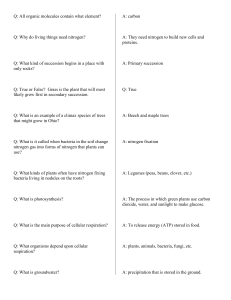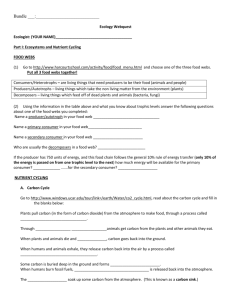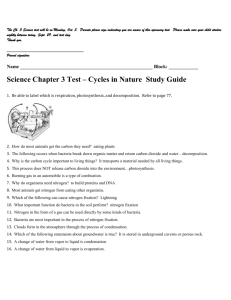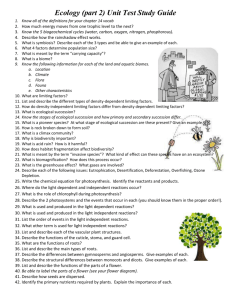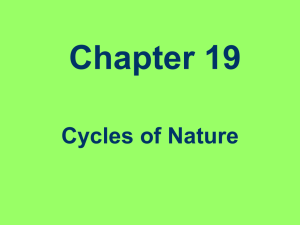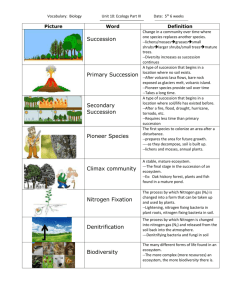Cycles in Nature Study Guide Matter moves between the
advertisement
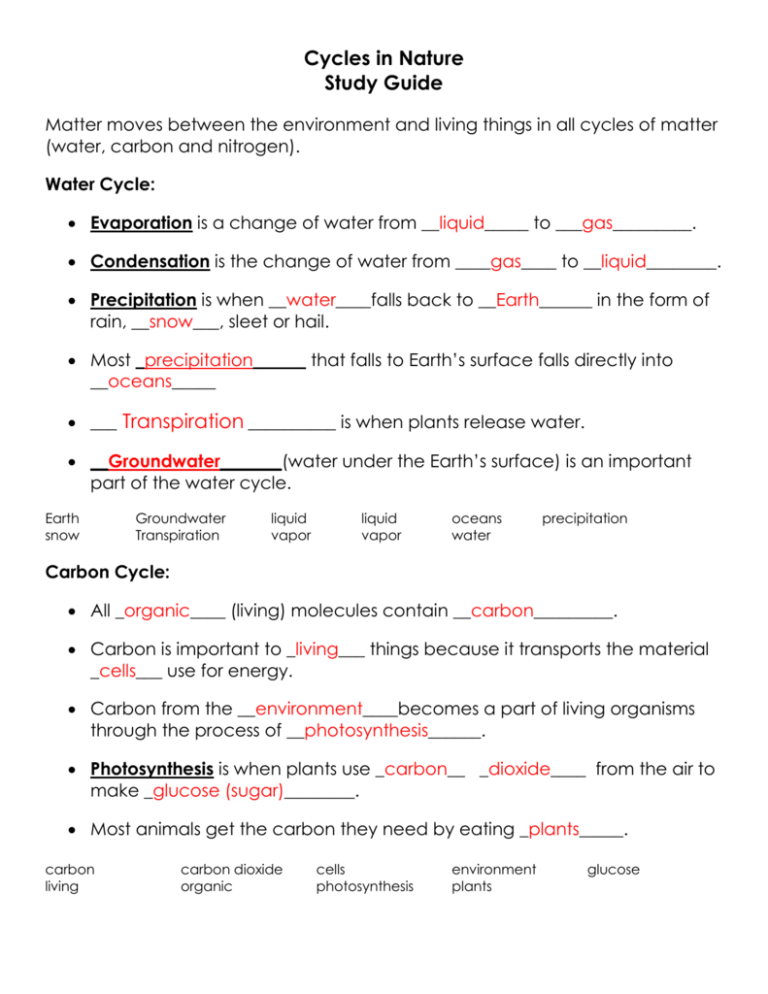
Cycles in Nature Study Guide Matter moves between the environment and living things in all cycles of matter (water, carbon and nitrogen). Water Cycle: Evaporation is a change of water from __liquid_____ to ___gas_________. Condensation is the change of water from ____gas____ to __liquid________. Precipitation is when __water____falls back to __Earth______ in the form of rain, __snow___, sleet or hail. Most _precipitation______ that falls to Earth’s surface falls directly into __oceans_____ ___ Transpiration __________ is when plants release water. __Groundwater_______(water under the Earth’s surface) is an important part of the water cycle. Earth snow Groundwater Transpiration liquid vapor liquid vapor oceans water precipitation Carbon Cycle: All _organic____ (living) molecules contain __carbon_________. Carbon is important to _living___ things because it transports the material _cells___ use for energy. Carbon from the __environment____becomes a part of living organisms through the process of __photosynthesis______. Photosynthesis is when plants use _carbon__ _dioxide____ from the air to make _glucose (sugar)________. Most animals get the carbon they need by eating _plants_____. carbon living carbon dioxide organic cells photosynthesis environment plants glucose Combustion is the _burning____ of a substance. Respiration is when sugar __molecules_____ are broken down by __plants___ to release energy. Carbon dioxide and __water___ are released as byproducts of this process. Combustion, respiration and ___decomposition____ all release carbon dioxide into the environment. _Photosynthesis____ does not. Decomposition is the _breaking___ __down___ of substances into simpler molecules. Bacteria’s breaking down organic matter and returning carbon dioxide and water to the environment is an example of ___ decomposition. molecules decomposition breaking down Photosynthesis burning plants decomposition water Nitrogen Cycle: 78_% of the Earth’s ___atmosphere___ is nitrogen gas, but most organisms cannot __use__ it in this form. Nitrogen is important to living things because it builds new __cells___. Nitrogen gas must be chemically ____transformed____ (changed) before it can be used by plants. __Bacteria____ that live in the soil have the important function of nitrogen __fixation______. __Lightning___can cause nitrogen fixation. atmosphere Lightening Bacteria transformed cells use fixation Ecological Succession: Succession is the replacement of one type of ___community _____ by another over time_________. Rock slowly transforming into soil is an example of __primary____ succession. _Lichen_____ is an example of a pioneer species. Secondary succession is when an existing community is _destroyed______ by a natural _disaster_____ or other type of disturbance. A forest __growing_______ back after a forest fire is an example of _secondary________ succession. community Lichen destroyed primary disaster secondary growing time The first plants that would grow on __abandoned__________ farmland would be __weeds____. Secondary succession _differs____ from primary succession in that it occurs in an area that has __soil___________. Climax species grow slowly and are well-adapted________ to an environment. A __mature____ community always has well-adapted organisms. Biodiversity is when a variety____ of species are present in an area. abandoned soil adapted variety differs weeds Be able to answer the following questions. mature Does the process of succession end? Explain. Suppose a scientist proposes a plan to destroy all bacteria on Earth in order to get rid of diseases caused by bacteria. Explain why it would be a good idea to approve this plan or not. Carbon may be in the environment for millions of years before it is released into the air where living things can use it. Give an example of how this may happen. Be able to label a diagram of the water cycle: precipitation evaporation condensation transpiration run-off groundwater Be able to label a diagram of the carbon cycle: respiration photosynthesis decomposition Be able to trace the steps of primary succession or secondary succession in a picture.

